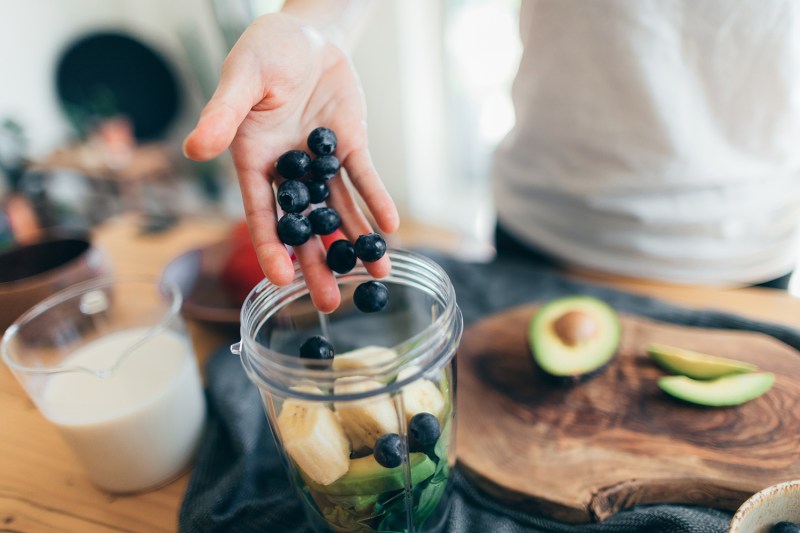
We’ve all experienced it. That moment where your partner or friend hands you a glass of some sort of unidentifiable, brownish-green, lumpy goo they call a smoothie — expecting you to guzzle it down with delight. Not to hurt their feelings, you do, holding back tears and your gag reflex.
A huge misconception out there is that you can blend up any combination of healthy ingredients and expect the result to taste like a smoothie from your favorite local juice bar. Sadly, this is not the case. Like with any food recipe, smoothies need to follow specific guidelines to get the best end product. You also need to add ingredients with complementary flavors.
To help boost your smoothie knowledge, we teamed up with former chef for the Boston Bruins (where he earned a Stanley Cup ring), the Cleveland Indians (for which he earned an American League Championship ring), certified dietary manager, and founder of Go Buddha Meals — Joshua Ingraham. If that isn’t enough proof that he knows his stuff, too bad because he’s also a master martial artist.
If you’re here for a specific smoothie recipe, you may be disappointed. We’re breaking down the perfect smoothie characteristics and how to make sure every smoothie you make has them. As long as you follow our checklist below for building a delicious smoothie, you can play around with the ingredients. After all, one of the best parts about making a smoothie is experimenting with flavors.
What are benefits of consuming smoothies?
Smoothies can be a convenient way to consume more fruits and veggies, which are packed with vitamins, minerals, fiber, and antioxidants. These nutrients can contribute to a healthy diet and potentially reduce the risk of chronic diseases.
Blending fruits and vegetables into smoothies can break down their cell walls, making some nutrients like beta-carotene more readily available for absorption. Smoothies with water or milk as a base can contribute to your daily fluid intake. And lastly, including fiber-rich ingredients like fruits with skin, leafy greens, nuts, and seeds can promote better digestion and gut health.

How to make a smoothie according to all aspects of the drink
There are five main aspects to consider when making your daily smoothie; texture, sweetness, color, acidity, and nutrition. Let’s dive in.
Texture
When it comes to texture, you ideally want your smoothie to be, well … smooth. This means a perfect balance of liquids and solids. A smoothie that’s too thick is a task to drink, and a smoothie that’s too thin is more like juice. Also, suppose you’re trying to boost your smoothie’s nutritional content by adding fibrous fruits and veggies. In that case, you’re going to need a powerful blender to make sure they’re drinkable. Getting the right texture for a smoothie is one of the hardest parts to master and takes practice. Chef Ingraham has a great tip on how to create a smoothie with great texture.
Sweetness
Spiciness, sourness, saltiness, or savoriness are not really the flavor profiles that come to mind when craving a smoothie. Sweetness, however, is almost always expected to some degree. When it comes to smoothies, the idea is to sweeten them naturally through juice and fruits. You can also use other naturally occurring sweeteners like honey or agave nectar in moderation.
Color
Like with any dish, presentation also matters with smoothies. You can craft the most delicious smoothie in the world, but if it’s an off-putting color, you’re going to be the only one willing to drink it.
Acidity
The best way to balance the sweetness of a smoothie and add a nice, crisp aftertaste is by adding a bit of acidity. Citrus is a good source of acidity and can be derived from the juice or the fruit itself for added fiber. Whatever you do, though, don’t go adding vinegar to your smoothies.
Nutrition
Not all smoothies are good for you. After all, milkshakes are technically a form of smoothie. However, if you’re using a nice balance of fruits, veggies, and dairy you will naturally get a nutrient-rich drink. Smoothies are also a great way to incorporate supplements into your diet for added nutrition. Just be aware of any added sugar in any supplement mixes that can shock your system.

Chef Ingraham’s step-by-step guide for the perfect smoothie
Texture: To achieve the best texture, try freezing your juice into ice cubes, portion into small sandwich bags, and pull them out to temper one at a time per smoothie. The tempering won’t melt the cubes; instead, it will allow them to soften just enough to help you achieve optimum smoothie texture.
Sweetness: Use ripe to very ripe fruit to supplement the sweetness. There’s no need to add calorically dense sweeteners that will wreck your blood sugar. Smoothies can be an outstanding way to get additional nutrients into your body. Another tip is to add frozen grapes to help sweeten. The fiber of the whole grapes will help ease your glycemic load.
Color: There is one rule I tell my kids when they are painting, and that is not to mix all the colors together; you always get brown. In smoothies, color matters. Try keeping like colors together. Bananas being the only exception.
Acidity: Balancing your smoothie with the right citrus is key to achieving a bright flavored drink. Just be careful with adding too much acid to a smoothie recipe with high-fat milks or coconut milks as the results may separate or, worse, curdle.
Nutrition: Eating whole food is incredibly important to trigger our body’s digestion; however, one smoothie a day, especially after breaking your fast (breakfast), could be exactly what your body needs to wake up and crush the day!
The proper steps for blending like a pro
Now that you understand the composition of the perfect smoothie, and have an idea of what ingredients you want to include in yours, let’s go over the proper blending technique. Like cleaning a fish or baking a cake, things need to be done in a particular order to get the best results. Below is how chef Ingraham makes his smoothie every time.
- Add 1/2 the liquid; this will help your machine ease into the blend creating as much centrifugal force as possible before grinding the larger ingredients.
- Add the leafy ingredients, if any. This will create a layer to buffer the blade from being weighed down by the force of other larger ingredients.
- Add the larger, most often frozen parts to the recipe. These ingredients will use their own gravity to push down the leafy ingredients.
- Double-check that everything is off or turned down to the lowest setting.
- Cover the top, keeping enough space for you to stream in the remaining half of your liquid.
- Start at medium speed to allow the machine to establish a defined vortex, slowly add your other part of the liquid to help feed the remaining unblended ingredients into the vortex.
- Turn up the speed to high, keeping the top closed for 20 seconds or until smooth.
Note: If you start too fast and lose the vortex, just turn off the machine and start ramping up the speed again until the vortex reappears.

Final tips
There you have it, everything you need to know to make the perfect smoothie. We promise, as long as you follow these guidelines, your smoothie will be great. Here are some final parting tips from chef Ingraham.
- Overall, if you can, use whole fruit pieces.
- Stay away from powders (with the right ingredients, you can craft a well-balanced smoothie packed with nutrition).
- Looking for something different? try pairing herbs from your garden with your smoothies. It adds an incredible floral aspect to them, which, when paired correctly, can make for an outstanding smoothie experience.



